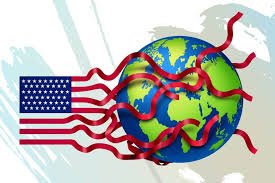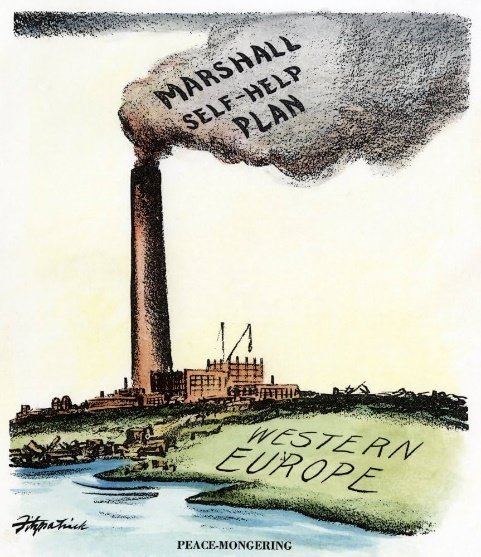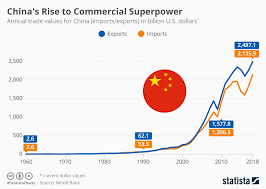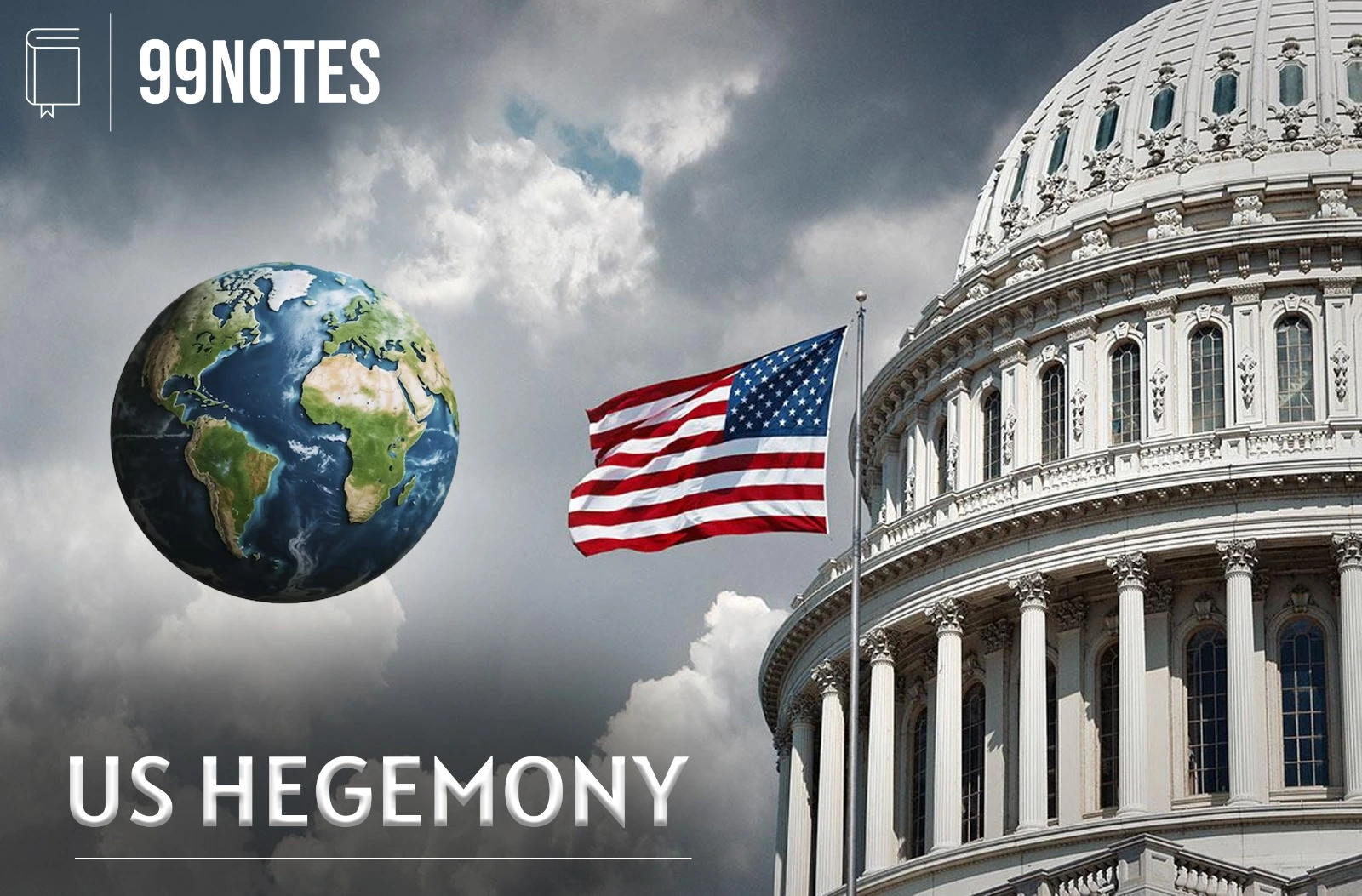US Hegemony
US Hegemony refers to its dominance in economic, military, political, and cultural spheres, shaping global affairs since World War II. Emerging as a superpower, the U.S. established institutions like the UN, IMF, World Bank, and NATO to reinforce its influence.
During the Cold War, it positioned itself as the leader of the “Free World,” countering the Soviet Union through military and economic strategies. The collapse of the USSR in 1991 marked the peak of US Hegemony, promoting liberal democracy and globalization. 
Beyond politics, its cultural influence through Hollywood, technology, and English as a global language further solidified its position. However, in the 21st century, challenges from rising powers like China, economic crises, and shifting alliances have questioned its dominance. While some view US Hegemony as declining, others argue it is evolving to adapt to new global dynamics.
Foundations of US Hegemony
The foundations of US hegemony were laid through its economic expansion, industrial growth, and military engagements, gradually positioning it as a dominant global power. While the U.S. initially followed an isolationist approach, key historical events such as World War I and World War II transformed it into a global leader.
- Economic Rise (19th–20th Century): The U.S. underwent rapid industrial growth, becoming a leading industrial power through manufacturing, transportation, and financial expansion. The rise of Wall Street, banking networks, and major corporations in steel, automobiles, and consumer goods positioned the U.S. as a global economic powerhouse by the early 20th century.
- World War I & Interwar Period: The U.S. entered World War I in 1917, emerging as a creditor nation by financing European allies. It became the world’s financial centre, but isolationist policies and trade protectionism defined the interwar years. The 1929 stock market crash and Great Depression weakened global economies, though the U.S. retained influence through innovation and financial restructuring.
- World War II & Aftermath: World War II cemented U.S. economic and military supremacy as it emerged from the war economically strong while Europe and Asia lay in ruins. The Bretton Woods system (1944) established the S. dollar as the global reserve currency, reinforcing financial dominance. The creation of the UN, IMF, World Bank, and NATO solidified U.S. leadership in global governance, marking a shift from isolationism to active global leadership and the full emergence of US hegemony.
The U.S. as a Global Superpower
The end of World War II marked the beginning of the United States’ unparalleled dominance in global affairs. With its economy intact and military strength unmatched, the U.S. played a central role in shaping the post-war international order. It established global financial institutions, aided war-torn nations, and led military alliances to counter Soviet influence, consolidating its position as a superpower.
- Bretton Woods System (1944): The Bretton Woods Conference established a S.-dominated global financial system, making the U.S. dollar the world’s primary reserve currency, backed by gold. The creation of the IMF and World Bank reinforced U.S. economic leadership by providing financial stability and economic assistance to struggling nations.
- Marshall Plan & Economic Influence:
 To counter communism and stabilize Europe, the U.S. launched the Marshall Plan (1947), investing $13 billion in rebuilding war-torn European economies, strengthening capitalist economies, and securing U.S. economic influence. The U.S. also played a key role in Japan’s post-war recovery, transforming it into an industrial power and securing long-term economic ties.
To counter communism and stabilize Europe, the U.S. launched the Marshall Plan (1947), investing $13 billion in rebuilding war-torn European economies, strengthening capitalist economies, and securing U.S. economic influence. The U.S. also played a key role in Japan’s post-war recovery, transforming it into an industrial power and securing long-term economic ties. - Military Dominance (NATO & Cold War): The North Atlantic Treaty Organization (NATO, 1949) secured U.S. strategic interests in Europe against Soviet expansion. The U.S. also maintained nuclear superiority and engaged in proxy wars in Korea, Vietnam, and Latin America, expanding its military presence through bases in Europe, Asia, and the Pacific to reinforce global hegemony.
- Containment of Communism: The Truman Doctrine (1947) guided U.S. efforts to contain Soviet influence, leading to major military conflicts like the Korean War (1950–53) and Vietnam War (1955–75), though Vietnam ended in failure. The Cuban Missile Crisis (1962) was a defining Cold War confrontation where U.S. diplomatic and naval pressure forced the Soviet Union to withdraw nuclear missiles from Cuba, solidifying U.S. global leadership.
The post-WWII era firmly established the United States as a global superpower, not just through economic and military strength but also through ideological and strategic leadership. The institutions and alliances formed during this period laid the foundation for continued U.S. dominance in world affairs.
Peak of US Hegemony (1991–2000s)
The period from the early 1990s to the 2000s marked the height of U.S. global dominance. With the collapse of the Soviet Union, the United States became the world’s sole superpower, shaping global economic policies, military interventions, and cultural trends. This era saw the expansion of globalization, neoliberal economic policies, military engagements, and the rise of U.S. technological dominance, reinforcing its hegemony.
- End of Cold War (1991): The collapse of the Soviet Union ended the Cold War, leaving the U.S. as the world’s sole superpower. With no ideological rival, it promoted a unipolar world order, advocating democracy and free markets. NATO expansion and the integration of former Soviet states into the global economy further strengthened U.S. influence.
- Globalization & Neoliberal Policies: The 1990s saw rapid globalization, driven by U.S.-led institutions. The WTO (1995) promoted global trade under American economic models, while the Washington Consensus encouraged free-market reforms in developing nations. The dot-com boom and financial expansion positioned the U.S. as the global economic engine.
- Cultural Influence:S. soft power grew through Hollywood, music, and television, shaping global culture. McDonald’s, KFC, and Starbucks became symbols of American consumerism. The digital revolution saw the rise of Google (1998), Microsoft, Apple, and Amazon, reinforcing U.S. dominance in technology and information networks. English became the global language of business and diplomacy.
- Military Interventions:S. military supremacy led to interventions reinforcing its global role. The Gulf War (1991) swiftly expelled Iraq from Kuwait, showcasing U.S. military strength. The Kosovo War (1999) emphasized NATO’s role under U.S. leadership. After 9/11 (2001), the War on Terror led to the invasions of Afghanistan (2001) and Iraq (2003), asserting U.S. military dominance but resulting in prolonged conflicts with major geopolitical consequences.
During this period, the U.S. maintained absolute military, economic, and cultural supremacy, shaping global policies with little opposition. However, signs of resistance and emerging challenges, particularly from China and Russia, began surfacing toward the late 2000s, setting the stage for a shift in global power dynamics.
Challenges to US Hegemony (2000s–Present)
Since the early 2000s, US hegemony has faced significant challenges from rising global powers, economic crises, and shifting geopolitical alliances. The once unchallenged dominance of the U.S. has been tested by the rapid ascent of China, Russia’s resurgence, the emergence of regional powers, and the consequences of prolonged military engagements. Economic instability and domestic political polarization have further complicated its global leadership.
- Rise of China:
 China has become the biggest challenge to U.S. dominance, rapidly expanding its economy, military, and global influence. Since joining the WTO in 2001, it has grown into the world’s second-largest economy, leading in manufacturing and technology. The Belt and Road Initiative (BRI) has strengthened its global economic presence, while military modernization and assertiveness in the South China Sea challenge U.S. supremacy in the Indo-Pacific.
China has become the biggest challenge to U.S. dominance, rapidly expanding its economy, military, and global influence. Since joining the WTO in 2001, it has grown into the world’s second-largest economy, leading in manufacturing and technology. The Belt and Road Initiative (BRI) has strengthened its global economic presence, while military modernization and assertiveness in the South China Sea challenge U.S. supremacy in the Indo-Pacific. - Regional Power Shifts: The unipolar world is shifting towards multipolarity, with regional powers asserting influence. Russia’s resurgence through military interventions in Georgia (2008), Ukraine (2014, 2022), and Syria (2015) has challenged U.S. interests. The EU seeks strategic autonomy, while India emerges as a rising power, maintaining independent diplomacy between the U.S. and Russia.
- Economic Crises: The 2008 Financial Crisis exposed U.S. economic weaknesses, leading to recession, rising debt, and stagnation. Manufacturing decline and outsourcing to China have weakened U.S. economic dominance. Trade deficits and economic inequality persist, while the U.S.-China trade war (2018–present) highlights growing tensions between the two superpowers.
- Declining Military Influence: Prolonged wars in Afghanistan (2001–2021) and Iraq (2003–2011, 2014–present) have damaged U.S. credibility, exposing the limits of military interventions. The chaotic Afghanistan withdrawal (2021) marked a major setback. Traditional allies like Turkey and Saudi Arabia are pursuing independent policies, while the rise of BRICS, SCO, and AUKUS signals a shift towards a multipolar world where U.S. authority is increasingly contested.
While the U.S. remains a dominant global power, these challenges signal the gradual erosion of its unipolar hegemony. The world is witnessing the rise of alternative power centres, forcing the U.S. to redefine its global role in an increasingly complex and competitive international environment.
US Hegemony in the 21st Century 
Despite facing significant challenges, the United States continues to maintain its global dominance through soft power, military alliances, technological leadership, and strategic diplomacy. However, the shifting geopolitical landscape, economic rivalries, and rising multilateral institutions indicate a transformation in the nature of US hegemony.
- Soft Power Diplomacy: The U.S. leads in technology, education, and entertainment, with Hollywood, social media, and universities shaping global culture. English remains the dominant language in diplomacy and business, while U.S. diplomatic efforts in climate agreements and democracy promotion reinforce its global leadership.
- Military & Strategic Alliances: The U.S. retains military supremacy through NATO expansion and partnerships like QUAD and AUKUS, countering China’s rise in the Indo-Pacific. It strengthens security and economic ties to maintain strategic control over key trade routes.
- Tech War & Economic Competition: The U.S.-China rivalry dominates global economics, with competition in AI, 5G, and semiconductors. Trade restrictions on Chinese firms like Huawei highlight efforts to control future technologies, while U.S. tech giants continue to lead innovation.
- Challenges from Multilateralism: Emerging organizations like BRICS, AIIB, and SCO challenge U.S.-led institutions like the IMF and World Bank. Calls for UN reforms and greater multipolarity indicate a decline in U.S.-centric global governance.
Conclusion
The future of US hegemony remains uncertain, with debates on whether it is in decline or adapting to a multipolar world. While the U.S. continues to lead in military, technology, economy, and culture, challenges from China, regional power shifts, and economic crises signal a shift in global power dynamics.
Despite setbacks, it retains strategic advantages through alliances like NATO, QUAD, and AUKUS, as well as its dominance in finance and diplomacy. The U.S.-China rivalry and technological competition will shape the next phase of global influence. While absolute hegemony may be fading, the U.S. is expected to remain a key global player, influencing international affairs in the coming decades.
Related FAQs of US Hegemony
US Hegemony refers to the dominance of the United States in global political, economic, military, and cultural spheres, particularly after World War II. It reflects the ability of the U.S. to shape international rules, influence other nations, and lead in areas like diplomacy, finance, defense, and technology.
The U.S. emerged as a hegemon after WWII through its economic strength, military superiority, and creation of global institutions like the UN, IMF, World Bank, and NATO. Initiatives like the Marshall Plan, Bretton Woods System, and containment of communism solidified its leadership during the Cold War era.
US Hegemony faces challenges from China’s economic rise, Russia’s military assertiveness, regional powers like India and the EU, economic crises (2008 Financial Crisis), prolonged military interventions, and the growth of alternative global alliances like BRICS and SCO promoting multipolarity.
The U.S. maintains dominance through military alliances (NATO, QUAD, AUKUS), control of global finance, technological leadership (Silicon Valley, AI, digital economy), cultural influence (Hollywood, English language), and strategic diplomacy in international institutions like the UN and WTO.
US Hegemony is not disappearing but evolving. While its unipolar dominance post-1991 has weakened due to rising powers like China, the U.S. still leads in military capability, technology, innovation, and global influence. The world is transitioning toward multipolarity, but the U.S. remains a central global player.





![Sangam Age: Literature, Map, &Amp; Dynasties [Upsc Exam Notes] | Updated April 24, 2025 Sangam Age: Literature, Map, &Amp; Dynasties [Upsc Exam Notes]](https://www.99notes.in/wp-content/uploads/2023/04/megalith-sangam-age-99notes-upsc-768x495.webp)